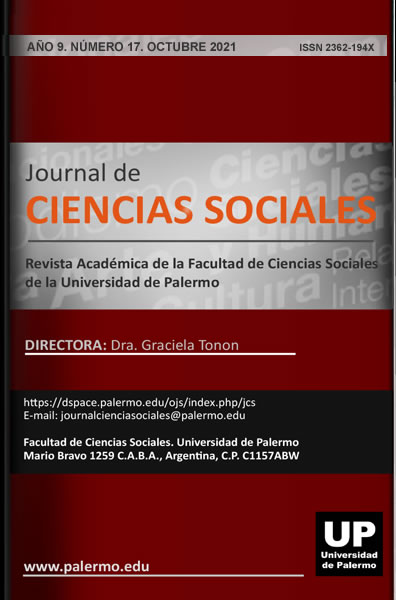Redes sociales: el carnaval, el mito y el héroe
Abstract
This article will not try to resort to determinisms, but rather appeal to generate new readings and questions from a critic perspective. We propose to address –regarding social networks- some theoretical conceptions about the carnival figure and the mask, and also, to develop articulations around the notion of exposure and the myth of the hero to re-think the citizen’s participation in the net. Furthermore, we’ll try to evidentiate the possible tensions with the commercialization of the every day life, through the creation of needs, non stop consumerism and the subjective manipulation underlying in certain market strategies via social networks, intensified even more in times of COVID-19. The mask and the characters represented are analyzers that allow us to visualize what might be beneath and so, they enable distinguishing between –what we here denominate- the invented identities (users) and the historically constructed identities, those that name us and give us belonging in a genealogy (our own name). In the complex social and symbolic organization that nets produce, we understand that there are expressions of multiple violences: of gender, environmental, economic, psychological, rights, the collective values. Under the logic of the social reproduction of inequalities, for there to be heroes it must have defeats.
Downloads
References
Ayala, P. (2014). Redes sociales, poder y participación ciudadana. Revista Austral de Ciencias Sociales, (26), 23-48.
Bajtín, M. (1984). Rabelais and his World. Indiana University Press.
Campbell, J. (1959). El héroe de las mil caras. Fondo de Cultura Económica.
Castoriadis, C. (1997). El Imaginario Social Instituyente. Zona Erógena, (35). https://cutt.ly/7Wcrn38
Debord, G. (1995). La sociedad del espectáculo. La marca.
Eco, U. (2004). Apocalípticos e Integrados. Editorial Tusquets.
Gértrudix, B. M., Borges, R. E., y García, G. F. (2017). Redes sociales y jóvenes en la era algorítmica. Telos, (107), 62-70.
Gianetti, C. (2001). Ars telemática: estética de la intercomunicación. En Cine, video y multimedia: La ruptura de lo audiovisual. Buenos Aires: Libros del Rojas.
Hurd, G. (productor) y Cameron, J. (director) (1984). Terminator [Cinta cinematográfica]. Cinema ´84.
Hütt Herrera, H. (2012). Las redes sociales: una nueva herramienta de difusión. Reflexiones, 91(2), 121-128.
Kubrick, S. (productor y director) (1968). 2001 Odisea del espacio [Cinta cinematográfica]. Metro-Goldwyn-Mayer (MGM)
Manovich, L. (2006). El lenguaje de los nuevos medios de comunicación. Paidós.
Mayer-Schönberger, V. y Cukier, K. (2013). Big Data. A revolution That Will Transform How We Live, Work, and Think. Madrid: Turner Publicaciones S.L.
McLuhan, M. y McLuhan, E. (2009). Las leyes de los medios. CIC. Cuadernos de información y comunicación, (14), 285-316.
Negroponte, N. (1995). Ser digital. Atlántida.
Nichols, S. (2019). Jung y el tarot. Un viaje arquetípico. Kairós.
Piscitelli, A. (2005). Internet la imprenta del siglo XXI. Gedisa.
Propp, V. (1928). Morfología del cuento. Editorial Fundamentos
Rhodes, L. (productor) y Orlowski, J. (director) (2020). El dilema de las redes sociales [Documental]. EU.: Exposure Labs.
Sibila, P. (2009). La intimidad como espectáculo. Fondo de Cultura Económica.
Turing, A. (1950). Computing Machinery and Intelligence, Mind (59), 433–460.
Vicente, J. y Subirós, O. (2015). Big Bang Data. Espacio Fundación Telefónica.
Watts, D. (2006). Seis Grados de Separación. La Ciencia de las Redes en la era del acceso. Paidós.
The authors retain the rights to their work guaranteeing this journal the right of first publication, committing to cite the Journal of Social Sciences as a reference of the original publication.
The works published in the Journal are published under the terms indicated in the Creative Commons License with the International Attribution 4.0 (CC BY 4.0).




























